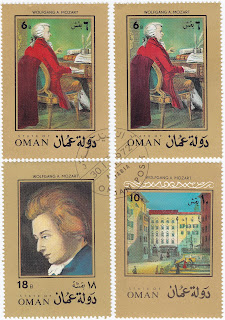Area: About 309,500 sq. km. (approximately the size of the State of New Mexico). It is bordered on the north by the United Arab Emirates (U.A.E.), on the northwest by Saudi Arabia, and on the southwest by the Republic of Yemen. The Omani coastline stretches 3,165 km.
The real "Sultanate of Oman" issues stamps that are real, and recognised by UPU.
The 'State of Oman',
also known as Dhufar (sometimes transliterated as Dhofar or Zufar) is one of the main regions of the Sultanate of Oman. Although Dhufar is historically, geographically and culturally distinct from Oman, there was always a close relationship between Oman and this region due to geographic proximity. The region was brought under closer control of Muscat's Al Bu Sa'idi sultans towards the end of the 19th century in an effort to thwart Ottoman designs upon Dhufar. Since then, Dhufar has always been an integral part of the Sultanate of Oman (officially known as Sultanate of Muscat and Oman before 8 August 1970).
Oman proper was ruled by Ibadite imams who exercised spiritual and often temporal authority over the region. There were often tensions between these imams and the sultans of Muscat and in 1913, the election of Salim ibn Rashid al-Kharusi as imam led to the proclamation of the Imamate of Oman with its capital at Nizwa.
In 1954, a new imam, Ghalib bin Ali, attempted to gain further Omani independence from Muscat, an effort that took Sultan Said Bin Taimur of Muscat and his British suzerains five years to suppress. In 1957, Nizwa was taken, the imam was overthrown and exiled, and his position was abolished. In 1959, the last forces of the Imamate were defeated. The name of the whole of Muscat and Oman was changed to the Sultanate of Oman.
The gouvernment in exile in Dhufar tried to establish an independent area in the north, and used also postage stamps to underline this 'independency'.
However, more than a year passed between his original plans for Dhufar stamps and their first issue. In the meantime, the situation for Oman Imamate State stamps became increasingly difficult: the imamate organization in exile gradually eroded in 1971 / 1972 as more and more Omani exiles and former followers of the Imam returned to Oman where Sultan Qaboos bin Sa'id had taken over from his father Sa'id bin Taimur on 23 July 1970. Friendly ties were soon established between the new Sultanate government and other Arab countries, including those which had hitherto supported the Imam.
The Sultanate of Oman acceded to the Arab Postal Union (with effect from 1 July 1971), to the Universal Postal Union (17 August 1971), the League of Arab States (29 September 1971) and to the United Nations (7 October 1971). After the Sultanate of Oman's accession to the APU, the Jordanian postal administration ceased to accept letters with Oman Imamate State stamps, thus depriving Tadros of the facility of producing postally used covers. Ultimately, the Syrian postal administration helped out: letters with Oman Imamate State stamps were accepted in Damascus in March and June 1972, which enabled Tadros to stay in business with his "State of Oman" and the new "Dhufar" stamps for a few more months.
The definitive issue of 15 April 1972 thus was the first and last Dhufar issue for which postally used covers exist.
From 1972 to 1986, stamps were produced without further legimity, both mint and CTO, as well as "First Day Covers", none of which, however, could be used postally.
source : http://www.oman.org/phil85.htm
Following stamps are from "the state of Oman" and are bogus.
 |
| the name of the capital city Nizwa is spelled Nazwa! |
On these cinderellas, the name 'state of Oman' changed into 'Dhufar'
... Any similarity to the labels of 'Staffa' ?
Popular themes on these labels are : scouting, domestic animals, wildlife, sports, music, paintings and historic personalities... in order to please all theme collectors.






2 comments:
The stamps of Staffa are not related to Oman or Dhufar in a geographical sense, but it is suspected that Clive Clive Feigenbaum, a British businessman known for his controversial philatelic ventures, was behind the printing of these stamps and those of Eynhallow and Nagaland. Staffa is an uninhabited island off the west coast of northern Scotland in the United Kingdom about six miles west of the Isle of Mull. It is the site of Fingal's Cave, a popular tourist attraction that receives thousands of visitors a year. There was a "post office" on the island in the 1970s which included a post box where visitors could drop their mail franked with Staffa stamps purchased from the tour boats that visited the island. The postal rate was twice that of the United Kingdom and paid for delivery to the government post office in Mull.
Thank you for the useful information.
There is an article on Staffa too.
I would like to copy the comment you posted, and paste it under that article too.
With kind regards
Post a Comment